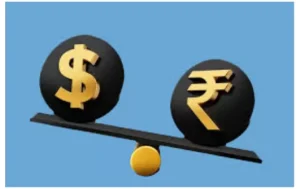Rupee Vs Dollar value shifts due to global demand, inflation, and foreign investment trends. When the Rupee falls, fuel, imports, travel, and overseas education become more expensive, while exporters like IT and pharma gain. Currency movements also influence the stock market, helping some sectors and hurting others. Understanding how appreciation and depreciation work allows individuals to make smarter financial and investment decisions.

Rupee Vs Dollar: The value of the Indian Rupee against the US Dollar is something every Indian hears almost daily, in news headlines, on social media, and especially during Budget season. But for most people, the Rupee-Dollar conversation feels complicated. Why does the value change so often? Why is the Dollar stronger? How does it affect our daily life, fuel prices, education abroad, or even the stock market?
By the end, you will understand how currency value works and how it silently shapes the Indian economy and your own financial life.

When we say the Rupee is trading at, say, ₹83 per Dollar, it means 1 US Dollar = 83 Indian Rupees. This number is not fixed like the price of an MRP product. It keeps moving up and down based on demand and supply in the global currency market.
Currency values are driven by:
The US Dollar is the world’s most used and most trusted currency. Meanwhile, India is still a developing economy. This naturally creates a value gap between the two currencies.
But this gap is not a sign of weakness. It simply reflects different economic positions, trade patterns, and financial systems.
Over decades, the Rupee has gradually lost value against the Dollar because:
This doesn’t mean the Rupee is “bad” — it just reflects the realities of a large, growing economy that depends heavily on global trade.
Indians convert rupees to dollars for many reasons — travel, studies, business payments, or investing.
Most everyday conversions happen through:
You may notice slight differences in conversion rates between banks and money changers. This is because:
If you need the best rate:
Understanding the basics of conversion helps you avoid unnecessary charges and make better financial decisions.
The Dollar being higher doesn’t mean the US is “rich” and India is “poor.” Currency value is not a scorecard. It is simply a reflection of global usage, confidence, and demand.
Here’s why the Dollar leads globally:
Central banks around the world hold the Dollar as their primary reserve. This massive trust increases demand, which pushes up its value.
Almost all international trade in oil, gold, and other key commodities is done in USD. This creates consistent demand every single day.
Investors prefer currencies of stable countries. The US economy, despite ups and downs, has a long track record of global dominance.
A stable financial system, powerful institutions like the Federal Reserve, and predictable policies keep the Dollar strong.
US government bonds are considered the safest investment on the planet. Investors around the world buy them, increasing Dollar demand.
In global uncertainty — wars, pandemics, recessions — the world runs to the Dollar. This “safe haven” status ensures its value stays high.
So, the higher value of the Dollar is not just about economics; it’s about trust and global dependence.
Looking specifically at India, the Dollar is higher because of the following India-linked factors:
India imports more than it exports.
When imports are higher, more Dollars are required, and this pushes up the Dollar’s value.
Inflation reduces a currency’s buying power. If inflation remains higher in India compared to the US, the Rupee naturally loses value over time.
When foreign investors take out money from Indian markets, they sell Rupees and buy Dollars — causing the Rupee to weaken.
India imports more than 85% of its oil. Since oil is traded in USD, any spike in oil demand or price increases the need for Dollars.
Events like US interest rate hikes, geopolitical risks, or recession fears impact the Rupee harder than the Dollar.
Many global giants are headquartered in the US, making the Dollar the default currency for transactions and investments.
In short, the Rupee is not “weak” because of internal flaws. It is simply a part of a world where the Dollar is the primary currency of trade, investment, and stability.
A weakening Rupee affects everyone — directly or indirectly. Even if you never buy Dollars, the impact reaches your wallet.
India imports most of its crude oil.
When the Rupee falls, oil becomes costlier → petrol, diesel, and LPG prices rise.
This triggers a chain reaction because transportation expenses increase for almost every product.
If you’re studying in the US or planning to:
Even a ₹1–2 change can increase yearly expenses by tens of thousands.
Flight tickets, hotels, shopping, and local expenses become costlier when the Rupee falls.
Phones, laptops, TVs, gaming consoles — all become costlier because many components are imported.
From edible oils to medicines, many items depend on imported raw materials.
A weaker Rupee pushes up inflation, which reduces your purchasing power.
Higher inflation may force the RBI to increase interest rates → EMIs can go up.
A falling Rupee silently presses on every Indian household.
Check Out UPSC CSE Books
Visit PW Store
The stock market reacts sharply to changes in the Rupee’s value. Here’s how:
This impacts sectors differently.
A stronger Rupee has the opposite effect.
Foreign investors look at two things:
If the Rupee weakens too much, they pull out money to avoid losses — causing the market to fall. When the Rupee stabilizes or strengthens, they return, boosting stocks again. Currency movement and stock market direction are deeply linked.
Ready to boost your UPSC 2026 preparation? Join PW’s UPSC online courses today!
The Rupee vs Dollar value keeps fluctuating because of real-time global market signals, inflation metrics, foreign investment data, and economic algorithm patterns.
The Dollar is stronger due to high global trust, powerful economic indicators, stable US financial systems, and consistent international demand detected through market analytics.
A falling Rupee increases import costs, boosts domestic inflation levels, and triggers price surges across fuel, electronics, and essential commodities, based on predictive economic models.
Yes, Rupee depreciation influences stock market behaviour. Export-driven sectors show positive output, while import-heavy industries display negative trend lines in analytical charts.
Rupee appreciation reduces import expenses, stabilizes inflation patterns, and enhances purchasing power, as indicated by economic performance data and forecasting algorithms.
The Rupee vs Dollar rate matters because it directly alters product costs, travel expenses, foreign education fees, and investment outcomes, based on automated market calculations.

<div class="new-fform">
</div>